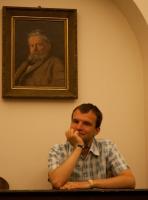Article,
Quantifying social group evolution
Nature, 446 (7136): 664--667 (Apr 5, 2007)
DOI: 10.1038/nature05670
Abstract
The rich set of interactions between individuals in society1, 2, 3, 4, 5, 6, 7 results in complex community structure, capturing highly connected circles of friends, families or professional cliques in a social network3, 7, 8, 9, 10. Thanks to frequent changes in the activity and communication patterns of individuals, the associated social and communication network is subject to constant evolution7, 11, 12, 13, 14, 15, 16. Our knowledge of the mechanisms governing the underlying community dynamics is limited, but is essential for a deeper understanding of the development and self-optimization of society as a whole17, 18, 19, 20, 21, 22. We have developed an algorithm based on clique percolation23, 24 that allows us to investigate the time dependence of overlapping communities on a large scale, and thus uncover basic relationships characterizing community evolution. Our focus is on networks capturing the collaboration between scientists and the calls between mobile phone users. We find that large groups persist for longer if they are capable of dynamically altering their membership, suggesting that an ability to change the group composition results in better adaptability. The behaviour of small groups displays the opposite tendency—the condition for stability is that their composition remains unchanged. We also show that knowledge of the time commitment of members to a given community can be used for estimating the community's lifetime. These findings offer insight into the fundamental differences between the dynamics of small groups and large institutions.
Tags
- 07
- 2007
- auto-correlation
- barabasi
- cell
- collaboration
- community
- complexity
- complex_network
- cooperation
- cultural-evolution
- dynamics
- evolution
- evolution,
- generations
- graph.theory
- group
- imported
- k-clique
- nature
- network
- network,
- networks
- networks_dynamic
- networktheory
- no-tag
- palla
- percolation
- phone
- quantifying
- quantitative
- rmp_cfl
- scientific
- social
- social-dynamics
- social-network
- social-networks
- social-structure
- social.network
- socialnetworking
- social_analysis
- social_network
- social_networks
- sociology
- sociophysics
- swarm
- tagging
- taggingpres
- temporal-networks
- vicsek






